Like Vasco de Gama and other Portuguese explorers, Lisbon, the city built on seven hills, awaits our discovery.
T-train to Shanghai– Last leg of the trip
We left Beijing Thursday evening around 7:30 PM on the sleeper train, and arrived in Shanghai the next morning about 9:30 AM. The “best” bunks are in the 4-person cabins (2 on each side of the tiny room) because they have a door that slides shut. There are also bunks in the hallways — three bunks high — but everyone walking to the bathroom or the dining car passes right by all night long. John had the top bunk on the right and I was on the bottom right. On the left bottom bunk was a Chinese lady about my age who spoke no English and on the top was a young man who was a student in Beijing whose major is computer translation (“translating Chinese into English efficiently on the Internet), so he spoke very good English even though we were the first foreigners with whom he had ever spoken. His only experience with the language was in English class. We really enjoyed meeting him and pumped him with lots of questions, especially when we found out he grew up in Inner Mongolia.
We received the royal treatment when we arrived at the Shanghai Railway Station. We were met at the train and chauffeured right to the Delta terminal at Pudong Airport an hour and a half away. This was a surprise that Tongan and Rui had arranged for us, and it saved us hours of public transportation in the rain. What a blessing! The last part of the vacation was the 18-hour trip from Shanghai to Savannah. It was great to see Brian and Sean at the airport waiting to drive us home!
My new rolling backpack held up under all conditions in China, but see what the U.S. airline did to it on the last 45 minutes of the trip! And all of the contents were soaking wet. They are paying me to purchase a new one. To be prepared for our next trip, I’m going to upgrade to the same one (Osprey) John has because it has a few extra bells and whistles for convenience and durability.
NEITHER RAIN NOR SLEET NOR HAIL STOP THE CHINESE COMMUTERS
Even really rainy days don’t stop people from bicycling to work. They all have nifty rain ponchos which cover not only themselves but the stuff they carry in their handlebar basket. Motor scooter drivers have even larger and more elaborate ponchos that snap onto their scooters.
Farmers work in the rain. Building construction and road crews work in the rain. Pedestrian traffic is just as busy in the rain. In fact, it’s a great day for the street vendors who hawk their wares to passers -by. They sell lots of umbrellas. We bought a cool leopard skin – looking one for $1.40.
We stood in a queue for about an hour one day in a heavy rain waiting for a taxi at the train station. So many in China do not have personal cars; life goes on in spite of the weather.
BEHOLD the infamous squatty potty. Oh, the stories you won’t hear!
One afternoon after a long bus ride to and tour of the ancient water township of Zhouzhang, the driver said he had time to stop and show us one more ancient historic site. Surprise! It turned out to be a Buddhist Temple complete with monks and people offering incense to idols. Since the whole visit was conducted in Mandarin, we blessedly didn’t understand a word but we surreptitiously stood in the background and observed some of the goings-on. Later in the bus on the way back to our hotel, we listened to our friends explain what had gone on behind the scenes that we opted out of. It turned out to be a divine opportunity to share our faith all the way back to Suzhou. And because they realized, after the fact, that they had actually been scammed and pressured into purchasing very expensive incense to wave before the Buddha idol to bring their family "luck", they were really interested in hearing about Christianity. We opened our mouths and the Holy Spirit filled us with words just for them.
There’s a big problem over here with counterfeit money. Every time you purchase something, the clerk or cashier scrutinizes each yuan. She holds it up to the light to see the water mark and other signs of real currency, snicks it to listen to the sound it makes, and turns it over several times. Finally it is accepted. Well, I guess they are so used to fake money that they don’t trust American money either. We have had money rejected several times when buying yuan with U.S. dollars. Once there was a pinkish stain on the top of a twenty dollar bill; another time there was a small tear. We had two types of fives (the old style and the new) and we almost had all those rejected. And they definitely don’t like old bills.
Lessons for future international traveling: (1) only take crisp, clean bills and (2) leave the traveler’s checks at home. No one knows what they are and won’t even consider cashing them. Bring an ATM debit card — but make sure it’s one of the major networks. Even then you might have trouble; some only accept local cards. China is pretty much a cash society. Only two times in two weeks have we been able to use a credit card. And when you do exchange your dollars for yuan, you get a great big, fat wad that barely fits in your wallet. One "ten" is only worth $1.40 and a "100" about $14. When you’re paying for something big like a deposit on your hotel room (2,000 yuan), you feel like a millionaire peeling off all those notes. And, yes, even the real ones look like funny money.
So many of the city busses are “double” — one driver, two busses. Public transportation is the way to go because there simply is not enough parking spaces. There are 70,000 taxis in Shanghai. Not sure how many are in Beijing…probably about the same. And there are almost as many bicycles and motor scooters (not motor cycles) as there are cars and taxis. In Suzhou and parts of Beijing, there are separate divided lanes for bikes. At each traffic light there may be 50 bikes and scooters waiting for the light to turn green. People carry groceries, dogs, and kids. The kids don’t even hold on; we’ve seen them eating or reading a book as they sit behind their parents zipping along at 30+ mph.
In the sections of Beijing, the scantily-stocked shops are tiny. They are called xiaomaibu and often the owners specialize. One may sell paper products, another bottles, and the next one bamboo steamer baskets. Very often vendors just spread an old blanket on the sidewalk and sell their goods from there — picking up and moving if business is slow.
We won’t be blogging again till we get home. LAST DAY: one more adventure in Beijing then the sleeper train to Shanghai. A final day in Shanghai before flying out in the evening. All without any sleep!
Pedestrian-only streets are very popular in the cities we’ve visited. Bicycles and motor scooters are also allowed on some. Wangfujing Lu is a Mecca for locals and tourists alike. You’ve got to watch the video John shot of one of the eating stalls on this famous "snack" street. Kabobs are ubiquitous but the scorpions, star fish, sea dogs, and lizards "take the cake". Watch closely and see what I mean. I thought I was being brave the other day when I had fried fish heads.
The market stalls were packed with shoppers and the vendors were very aggressive there. Several of them grabbed John’s arm and literally pulled him over to see their wares. I kept hearing, "Lady, lookee, lookee" as they would thrust some little trinket into my hand. Shopping was never so exhausting. Our friend, Rui, just thrives in this environment and she negotiated a few more deals for us this afternoon. I guess you have to grow up doing this kind of thing…but to me haggling is stressful. Give me Wal-Mart.
We got our first view of the Forbidden City from across the street in Tian’anmen Square – the site of the infamous 1989 student/police clash. The City is a complex of palaces, halls, gardens, towers, and gates that form the world’s largest surviving palace. It has 9,999 rooms and was completed in 1420 and served 24 emperors for 500 years. No commoner saw the inside until the the last Dynasty (Qing Dynasty) fell in 1911.
John and I spent about three hours wandering the halls and courtyards. It is immense, and they say it would take you 27 years to go into every single room. We were in the outer courtyard when some American students told us that McCain had conceded and Obama had been declared the next president. What a surreal moment that was there in the Imperial City to get that news.
Like everywhere we’ve been in China, the Forbidden City was full of crowds. There’s always pushing and shoving and jockeying for position. Let me give you two illustrations from today’s experience. In the ladies’ rooms, women in the U.S. typically line up and the first in line gets the next available stall. But in China you line up in front of each stall. Today there was a western toilet among all the squatty potty stalls, so I stood with my nose to the stall door. If I had been back a few paces, ladies would have just cut right in front of me. I watched a few foreigners. who thought they were in line, look in amazement as Chinese ladies walked right past them and queued up in front of stalls further inside the room.
John has experienced a phenomena quite a few times over the past two weeks; today being no exception. For some reason, the older women are particularly aggressive with him. He gets literally pushed and bumped.
As we were wading through the crowds in front of the Palace of Harmony, a little old grandma elbowed him right in the side. There was actually plenty of room for her to get by but she purposely jabbed him. It’s happened so many times that it’s now amusing. No one has done that to me. I certainly get cut in front of and pushed a bit, but no kung fu jabs.
The Great Wall is really impressive. The mountain range on which it was built is awesome –rugged and majestic. God’s creation combined with an engineering marvel is an unforgettable experience.
The Chinese have a saying for everything under the sun. One is that "he who climbs the Great Wall is a true man". You can buy a HERO card on the top of the wall inscribed with your name. Believe me, when you get to the top, you feel like a hero or a true "man". But as hard as it is to climb up, it is equally challenging to climb down. John described the condition of his legs — jello. At a few spots I had to bump down on my bottom like a toddler because of the steepness and depth of each stair, and near the end I was hanging onto John’s arm because my legs were shaking so hard I could hardly stand. But it was worth every step and bump.
What an incredible view! Another Chinese saying is "one step, one view" meaning that every time you move to another spot, there’s another great scenic vista. They use it for their "classical" gardens (one of which we spent a half day in — in Suzhou) but it is equally apropos here. Whether at the bottom looking up, or the top looking down, it is all marvelous.
The wall was built over a period of several dynasties, thousands of years ago. Millions lived and died in these mountains working on the almost 4,000 mile wall. We only saw a tiny portion but what we saw was amazing. Pictures will never do it justice but I hope you can get a sense of what it is like. I was reminded of the Biblical story of the Tower of Babel when God said that together there might be nothing man couldn’t do. He gave us amazing abilities to make incredible things. But all of that pales to His creation.
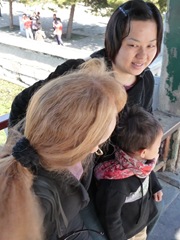 I’ve heard from my niece who’s living in China for a time that she sometimes feels like a movie star. I can now totally relate to what she tried to share about her experiences of being noticed everywhere she goes. John asked me yesterday how many pictures I thought I was in that day, and I thought he meant “how many he had taken of me”. But no, he had seen a lot of people snapping photos of me — some are blatantly obvious while others are more subtle. Depending on where we are (city and/or neighborhood, people take more notice of foreigners. Today we visited the Summer Palace of the Qing dynasty — the last of the imperial dynasties of China which fell in 1911. The red hair and freckles seemed to elicit a lot of attention today. Maybe because it’s a tourist spot and people are in a slower mode and have their cameras out ready to shoot scenic vistas, etc. Mothers bring their small children to me and indicate they’d like me to pose with their child (sometimes to the chagrin of the child). Today even the adults were asking for photo opportunities.
I’ve heard from my niece who’s living in China for a time that she sometimes feels like a movie star. I can now totally relate to what she tried to share about her experiences of being noticed everywhere she goes. John asked me yesterday how many pictures I thought I was in that day, and I thought he meant “how many he had taken of me”. But no, he had seen a lot of people snapping photos of me — some are blatantly obvious while others are more subtle. Depending on where we are (city and/or neighborhood, people take more notice of foreigners. Today we visited the Summer Palace of the Qing dynasty — the last of the imperial dynasties of China which fell in 1911. The red hair and freckles seemed to elicit a lot of attention today. Maybe because it’s a tourist spot and people are in a slower mode and have their cameras out ready to shoot scenic vistas, etc. Mothers bring their small children to me and indicate they’d like me to pose with their child (sometimes to the chagrin of the child). Today even the adults were asking for photo opportunities.
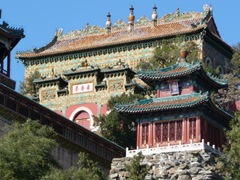 The palace grounds are extensive; we spent about 4 hours there and did not see everything. The complex includes the residential and official halls as well as many other buildings and temples and pavilions. There are over 700 acres of hills, lakes, islands, and woods arranged like the traditional “classical” Chinese gardens (or parks really). Royal gardens and common gardens are both laid out using 4 main elements: water, rocks, architecture, and plants. Interestingly, plants and trees are not the main feature of a classical garden.
The palace grounds are extensive; we spent about 4 hours there and did not see everything. The complex includes the residential and official halls as well as many other buildings and temples and pavilions. There are over 700 acres of hills, lakes, islands, and woods arranged like the traditional “classical” Chinese gardens (or parks really). Royal gardens and common gardens are both laid out using 4 main elements: water, rocks, architecture, and plants. Interestingly, plants and trees are not the main feature of a classical garden.
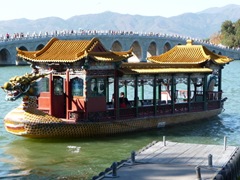 We took a ferry across the immense Kunming Lake to get closer to the palace. It was a bright sunny, brisk day — the foliage just barely beginning to turn. Weeping willow trees line the shore and mountains make a dramatic backdrop. It’s a gorgeous spot. John discovered a “secret” trail and we got up to the top of the highest point and had a marvelous view of Beijing’s skyline. Flocks of chirping magpies, China’s “lucky bird”, were up there with us. Striking black, white, and blue crow-size birds. They must have thought we were paparazzi because we took dozens of pictures of them.
We took a ferry across the immense Kunming Lake to get closer to the palace. It was a bright sunny, brisk day — the foliage just barely beginning to turn. Weeping willow trees line the shore and mountains make a dramatic backdrop. It’s a gorgeous spot. John discovered a “secret” trail and we got up to the top of the highest point and had a marvelous view of Beijing’s skyline. Flocks of chirping magpies, China’s “lucky bird”, were up there with us. Striking black, white, and blue crow-size birds. They must have thought we were paparazzi because we took dozens of pictures of them.
Beijing is a very modern city of over 20 million people, almost as populated as Shanghai but zoned very differently. The tall buildings are only 15-20 stories high as compared to Shanghai’s 75-100 storied ones. Even though Beijing’s perimeter is wide, it has the feel of a smaller city — more like a combination of Boston and Washington, DC.
We spent part of the afternoon around Hou Hai (Back Lakes), a cluster of three linked lakes north of the Forbidden City. They are right in the heart of a district of hutongs (labyrinths of alley ways — the ancient neighborhoods — where many people still live amid incredibly crowded and poor conditions). See my previous story about black market shopping in Shanghai’s hutongs.
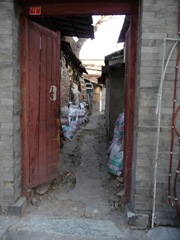 After we walked about the pretty lake area and strolled by the little boutiques, renovated from the old homes of privileged government workers, John got to see the hutongs up close and personal. Unlike the Shanghai 2–stored hutong buildings, these are only one level. They didn’t seem as cramped to me. But they are very old, very dirty, very dilapidated — and they are quite narrow. When a rickshaw would pass us, we’d have to move to the side. And actually we were just walking in the main alleys, we could see the side alleys, but they are private. It would be like walking up someone’s driveway or sidewalk or front yard.
After we walked about the pretty lake area and strolled by the little boutiques, renovated from the old homes of privileged government workers, John got to see the hutongs up close and personal. Unlike the Shanghai 2–stored hutong buildings, these are only one level. They didn’t seem as cramped to me. But they are very old, very dirty, very dilapidated — and they are quite narrow. When a rickshaw would pass us, we’d have to move to the side. And actually we were just walking in the main alleys, we could see the side alleys, but they are private. It would be like walking up someone’s driveway or sidewalk or front yard.
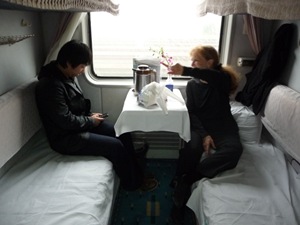
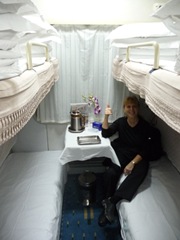
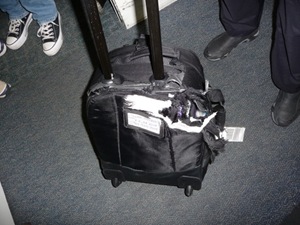
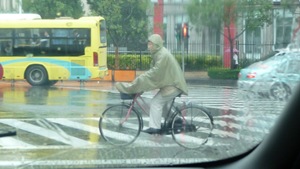
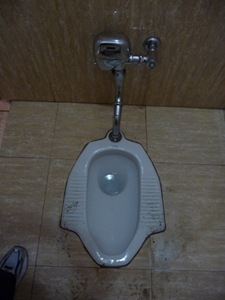
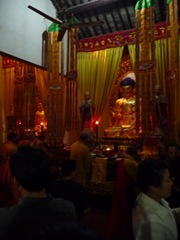
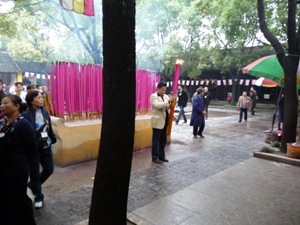
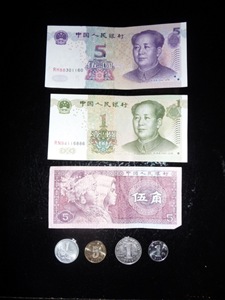
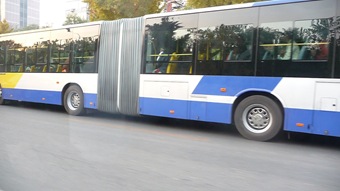
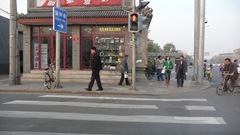
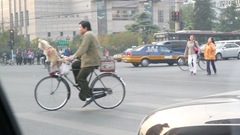

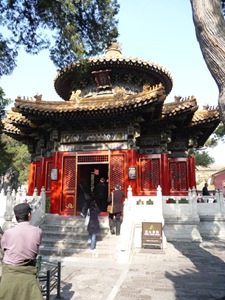
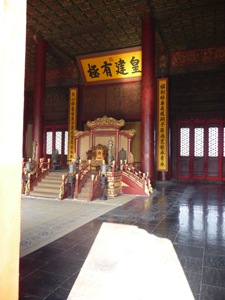
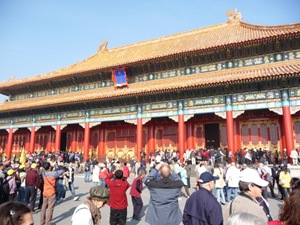
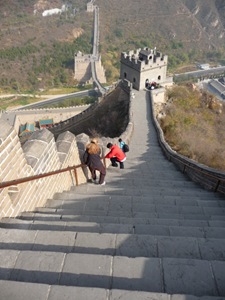
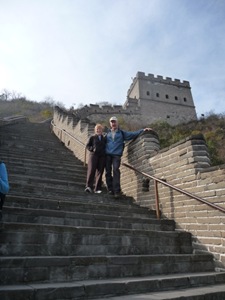
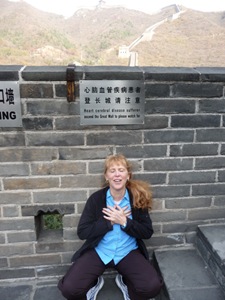
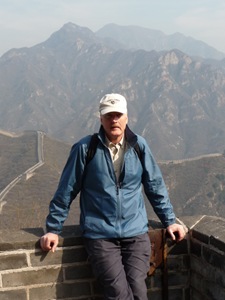
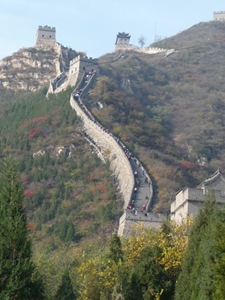

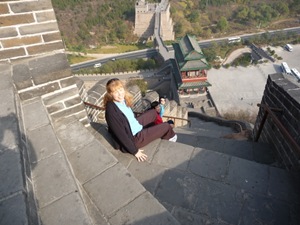
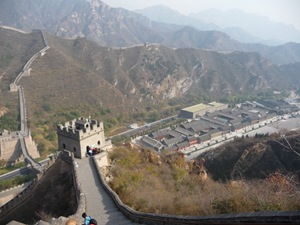
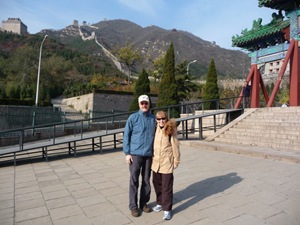
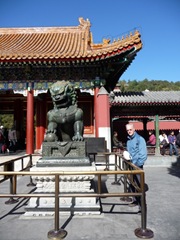
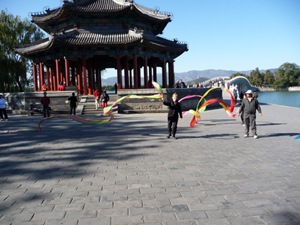
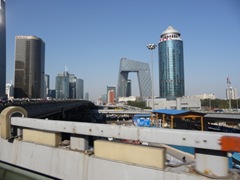
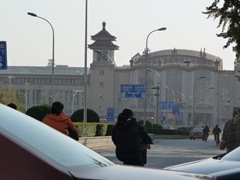
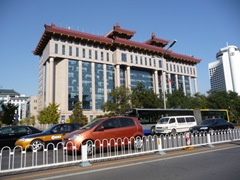
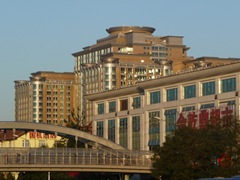
Recent Comments